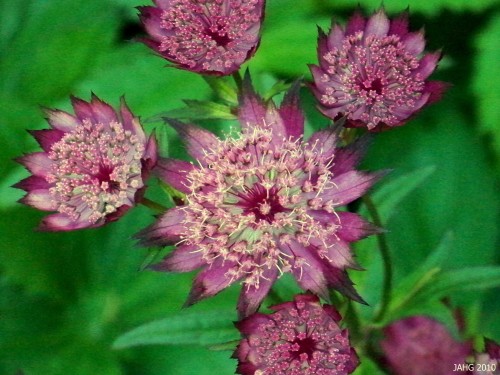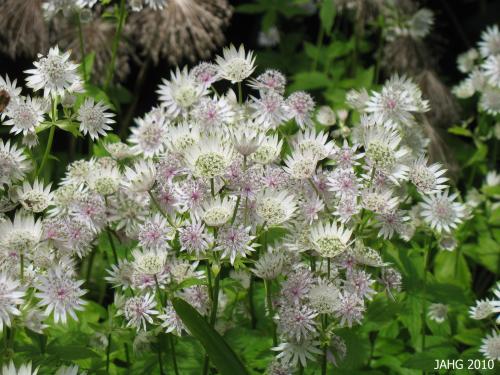The first time I was introduced to todays plant I really did not appreciate its sublime beauty. It was at I time when I knew to gardening in this mild west coast climate which was like coming to a treasure trove of exotic from the plant desert i had lived in. The plant in question was in the ‘white garden found in Park and Tilford Gardens where I was doing my practicum over the summer months. With experience I have learned big and bright are not always the most easy to work with in designing gardens whereas sublime and subtle are often the key to the best. Astrantias major (Masterwort) are delicate and sublime at the same time while being outstanding garden plants which deserve to be included in many more gardens.
Astrantias have long been known to gardens in Europe where they grow amongst the alpine meadows in the mountains of Austria through the Swiss Alps, and into the Pyrenees of north-west Spain. There at the high elevations and they bloom from July into September. (Great) Masterwort is first noted by English herbalist John Gerard(1545-1611-12?) in 1596 in his famous publication ‘Great Herball, or Generall Historie of Plantes’. In this book he wrote a detailed description of all the herbal plants which he had collected and grew at his garden in Holborn.

Frothy Astrantia major blooming with Alchemilla mollis make a beautiful floral display in this dappled spot.
Astrantia are without a doubt are recently being discovered by gardeners here in North America. I was lucky that many years ago to have experience them in the ‘white garden’ as I did not see them again until I came to Vancouver Island and worked as a grower at a nursery here. There I soon found that there were several color forms from dark red through pinks and creams. My favorite Masterwort was one called “Shaggy’ which has a large deeply toothed bracts which are green tipped on cream, it is sometimes sold as ‘Margery Fish’ and should only be propagated by division.

The tiny fertile flowers of Astrantia major are found in the middle of the papery green tipped bracts.
Astrantias are now used in many types of gardens as they are extremely versatile. Margery Fish, the influential English Cottage Gardener recognized their charm, as have many of the well know garden writers and designers of today. You can use Masterwort in full sun or nearly complete shade and still get a respectable showing of flowers. the flowers are extremely long-lasting because they are papery and dry quite well, this guarantee that they make their way into florist shops for their work. The leaves are clean and attractive.
Growing Masterwort is fairly easy as long as you remember a few important things. Astrantias like rich fertile soil which has the ability to retain some moisture during dry periods, these plants sulk if they get too dried out. They will flower best in full sun as long as there is sufficient water available.These are plants which do not like to have their roots disturbed therefore care must be taken when moving or dividing them, they can be slow to bounce back and patience is needed. To get a prolonged and repeat bloom remove spent flowers promptly, this will keep the plant vigorous.
To increase Masterwort you can do it in several ways by division or by growing them from seed. Division is done in the fall or spring when Astrantias are still dormant every 3 to 4 years. Division is the only way to increase your named varieties and keep them true to form and color. Seed may collected and germinates naturally on site if the plants are happy or you can do it yourself. The seed is multi-cycle dormant and I used a refrigerator to artificially speed up the process. Plants from seed will take several years to bloom using this method.
Before putting your Astrantias to bed in the late fall give them a side dressing of mulch and this will help them grow strong roots over the winter. Masterwort are listed as taking -20c(-4f) or zones 5 through 9. These are tidy plant which for slowly spreading clumps of 30-60cm(1-2ft) wide. Hieght of the plants varies from 30-90cm (12-36in) high at the most, most are around 60cm(2ft) tall. New varieties are being introduced, the darkest red so far is ‘Hadspen Blood’, ‘Shaggy is said to have the largest flowers. Another Astrantia you can grow is Astrantia maxima which has pinker flowers with thicker bracts.

Here in the 'Cutting Garden' at Government House, the Astrantias are used as an informal groundcover.
Use Astrantias in your perennial border, shade garden, woodland areas, informal areas, cut flower garden or butterfly and bee garden. Masterwort mixes well with many plants from Ferns to Rodgersia as well as Hostas, Heuchera, Tellima and Tiarellas and many others.
Mastering Astrantias:
Paghat is always a good place to start: http://www.paghat.com/masterwort.html
Astrantia ‘Shaggy’: http://www.telegraph.co.uk/gardening/3319801/How-to-grow-Astrantia-Shaggy.html
John Gerard, and one of the first important descriptive garden books: http://en.wikipedia.org/wiki/John_Gerard
Until we meet again soon on this leafy path….




 Stumble It!
Stumble It!






